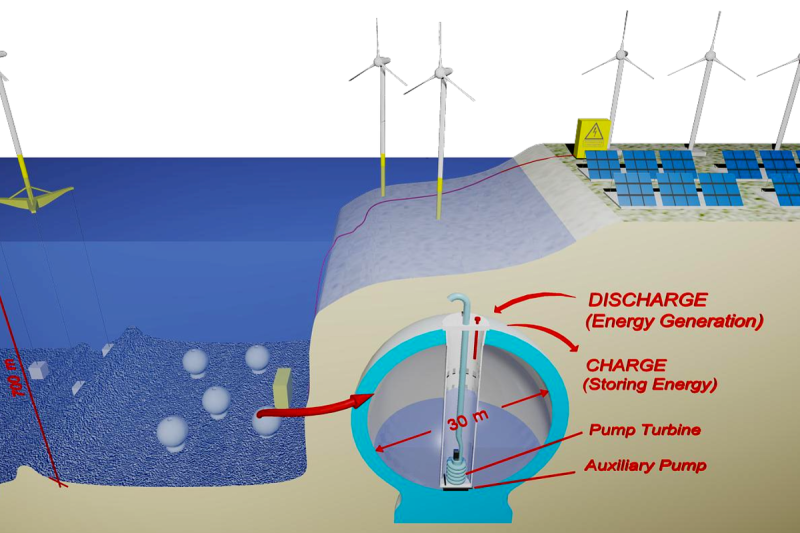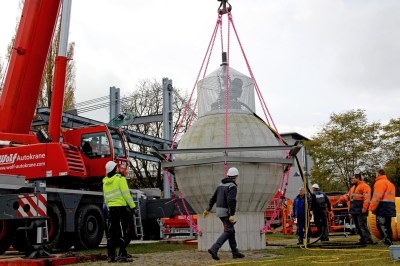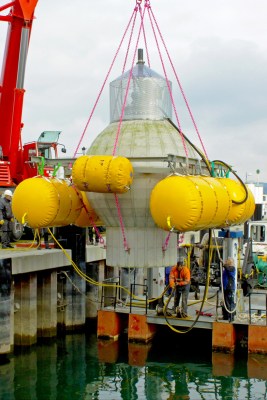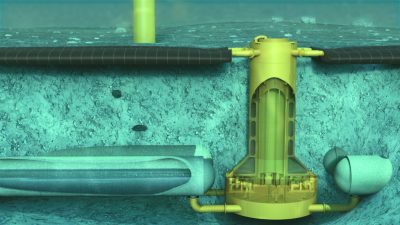
Pumped hydro storage is one of the oldest grid storage technologies, and one of the most widely deployed, too. The concept is simple – use excess energy to pump a lot of water up high, then run it back through a turbine when you want to get the energy back later.
With the rise in renewable energy deployments around the world, there is much interest in finding ways to store energy from these often-intermittent sources. Traditional pumped hydro can help, but there is only so much suitable land to work with.
However, there could be a solution, and it lurks deep under the waves. Yes, we’re talking about underwater pumped hydro storage!
It’s All Down Below

The basic concept of an underwater pumped hydro storage system is not dissimilar from that of its land-based cousin. The difference is all in the details of how you make electricity by pumping water around when you’re already under the sea.
The general idea is to have a closed vessel sitting on the seafloor. Surplus energy is then used to pump water out of this vessel, leaving the inside at a near-vacuum. When it’s desired to recover energy from the system, water can be allowed to flow back into the vessel under the pressure generated by the seawater above. As the vessel is filled, the water flowing in turns a turbine, generating electricity in just the same way as a traditional pumped hydro system.
The utility of such a design may not be obvious at first. However, there are several benefits to such a system. Primary among them is that such systems can easily be colocated with off-shore wind farms, prized for their power generation, but with sporadic output. Running underwater also allows the system to take advantage of the great pressure exerted by the sea above. For each 10 meters of depth, pressure increases by roughly one atmosphere (1 bar), and with a system designed to operate with vessels at near-vacuum when fully “charged”, there’s a huge differential to take advantage of. Some designs proposing to operate at pressures in excess of 75 bar. Efficiency of such systems is expected to lie around 70-80%, around the same as traditional pumped hydro storage.

The underwater design also eliminates the issue of evaporation, which saps water, and thus energy, from pumped hydro reservoirs. Installation is readily scalable, too. Each underwater reservoir only needs an electrical connection to the grid, and nothing more. Simply installing more reservoirs underwater with the appropriate electrical infrastructure will easily scale up the capacity of such an installation.
There’s also the simple advantage that there’s no need to find big mountains or valleys in which to build reservoirs, and no risk of those reservoirs bursting and destroying local cities in the surrounding area. Instead, seldom-used areas of seafloor are readily available, with very few housing developments or existing businesses down there to frustrate the building approvals process.
Early Days Yet
The most notable effort in this area is the Stored Energy at Sea project, also known as StEnSea for short. The brainchild of Dr. Horst Schmidt-Böcking and Dr. Gerhard Luther back in 2011, the basic idea lead to a grand concept of 30-meter diameter spheres on the ocean floor. These would be complete with integrated turbine pumps to empty them of water, while also generating electricity as it flows back in.
A 1:10th scale test of the full-scale concept went ahead in 2016. This involved the construction of a 3 m diameter concrete sphere, which would serve as the primary storage vessel. Sunk down to a depth of 100 meters in Lake Constance, Germany, the vessel was tested extensively for four weeks to determine the viability of underwater pumped hydro storage. The test was successful overall, with the engineering team able to operate the sphere, storing energy and recovering it later.
The results of the study, combined with other research, indicated to the team that the idea was feasible at depths of around 700 meters. Pressures at this depth are on the order of 70 bar, and serve to help the system generate large amounts of energy while still remaining in a safe zone regarding material strength concerns and the practicality of installation. It’s expected at this depth, a single sphere could store a full 20 MWh of electricity, paried with a turbine capable of generating 5 MW for a discharge time of four hours.
With multiple spheres ganged up in an off-shore installation, estimated storage costs when up and running would come down as low as a few cents per kWh, likely cheaper than comparable compressed air solutions, with construction costs coming in around $1,300 to $1,600 per kW of power output. The actual financial viability of such an operation, however, depends on the arbitrage price of energy in the market; one study suggests that a system of 80 such giant spheres, operating with a combined output of 400 MW, would be viable in ranges from 4 to 20 Euro cents per kWh.
Other efforts exist, too. Both MIT and a startup known as Subhydro have also explored the idea, similarly based around hollow concrete spheres on the ocean floor. The numbers arrived at by these teams, regarding depths, efficiencies, and power outputs are within the ballpark of those quoted by StEnSea, suggesting the basic engineering behind the concept is sound.

Meanwhile, a Dutch start-up by the name of Ocean Grazer is exploring a twist on the StEnSea concept. Instead of giant spheres, a concrete tube buried in the seabed is to be used as the pressure vessel. Additionally, rather than pumping water from the vessel out into the open ocean, it will instead pump its water into a sealed bladder. This still allows the system to take advantage of the pressure differential at the seafloor, but negates potential issues with a pump being fouled by marine flora and fauna, as it operates as a sealed system. Ocean Grazer has pivoted to the design having explored other renewable energy technologies such as wave power generation in the past. The company expects that one reservoir, with a capacity of 20 million liters of water, could store up to 10 MWh of energy.
The Ocean Grazer project, which won an award at CES 2022, is perhaps receiving the greatest press for underwater pumped hydro at the moment. Despite this, and the other projects that have bubbled under for the last decade, the technology still largely lives on paper and a large-scale installation seems to be a long way away. Regardless, the fundamentals are there, so if energy storage does suddenly become more important, or, let’s be honest – much more profitable – much of the required basic engineering has already been done. Implementing a major installation may just require the right economic conditions to happen in only a few short years!
0 Commentaires